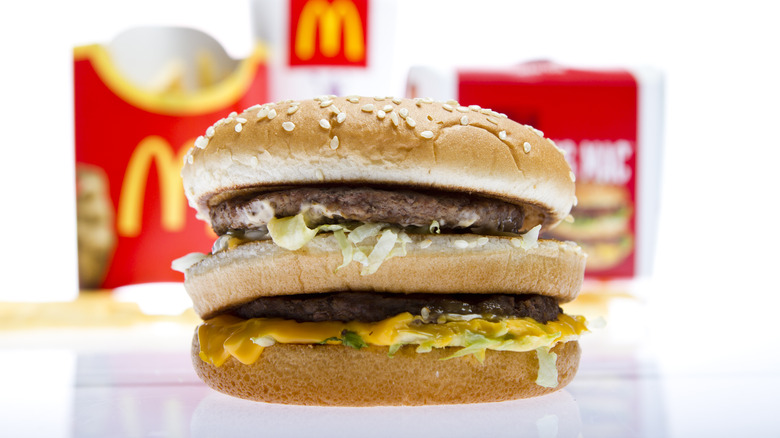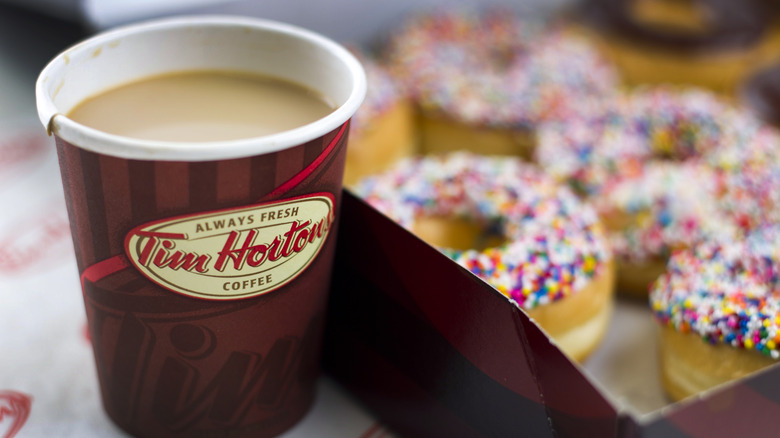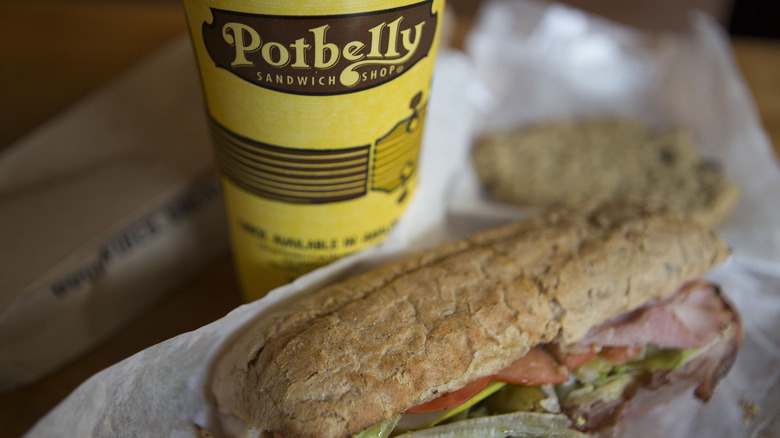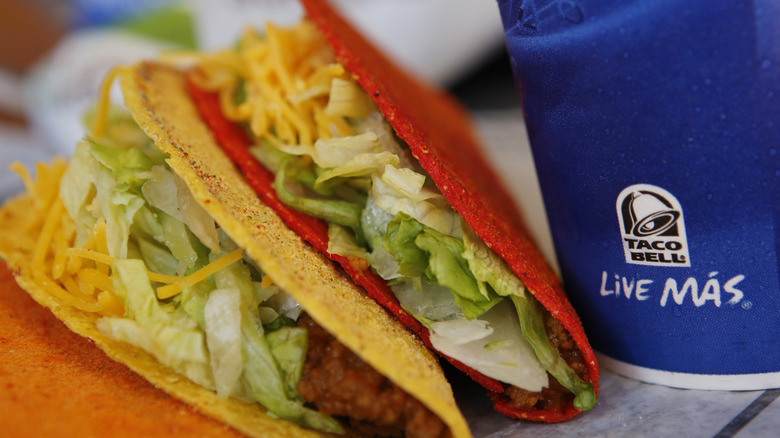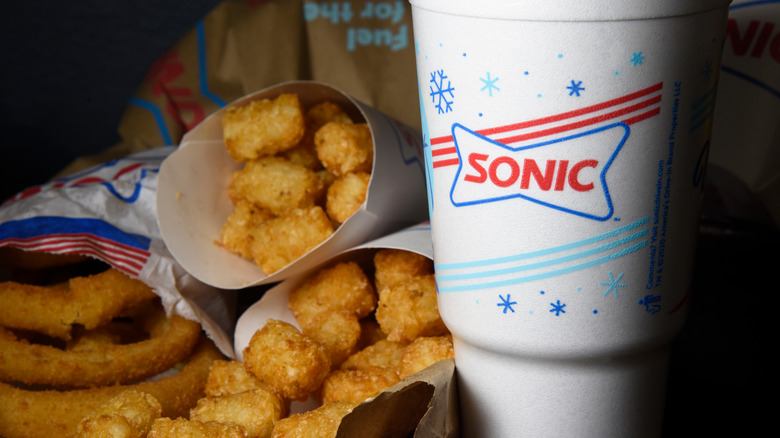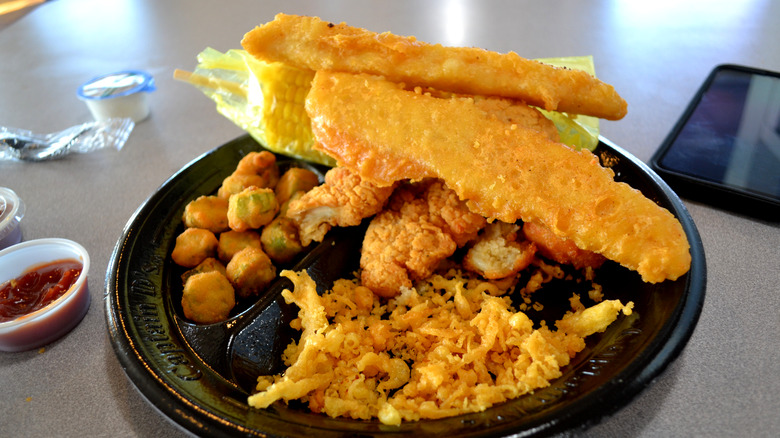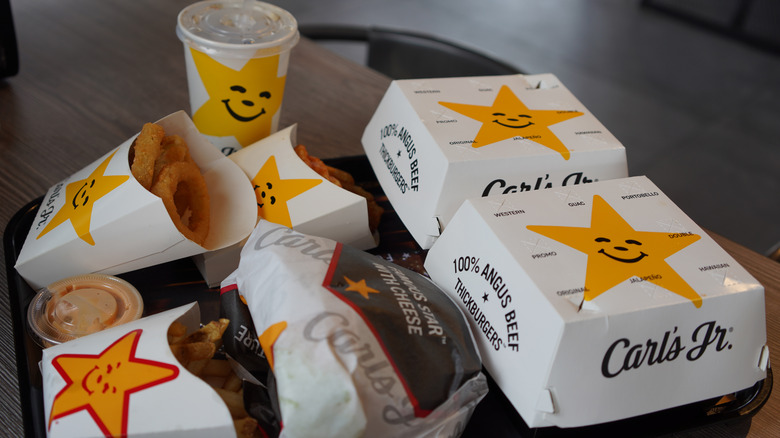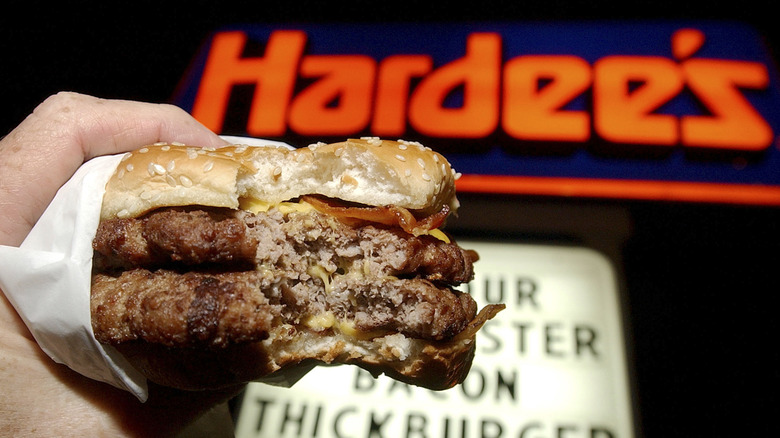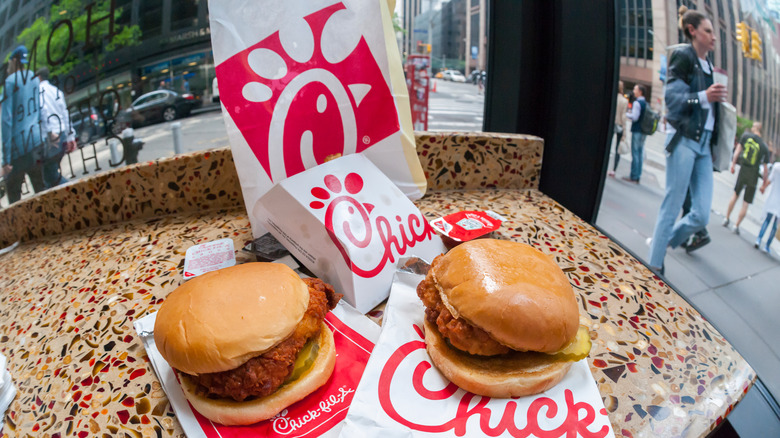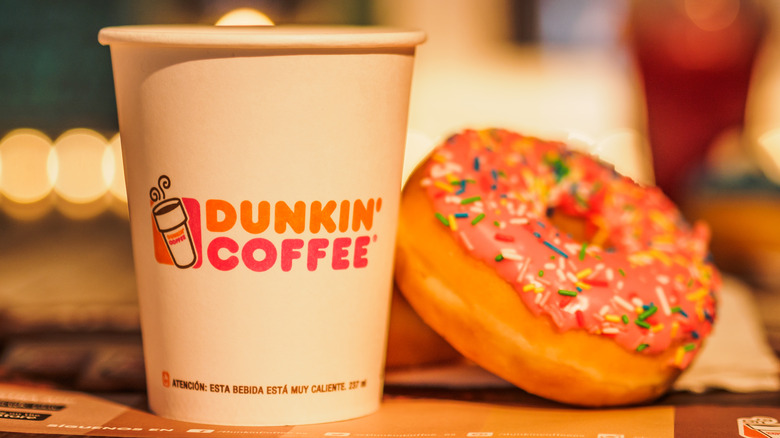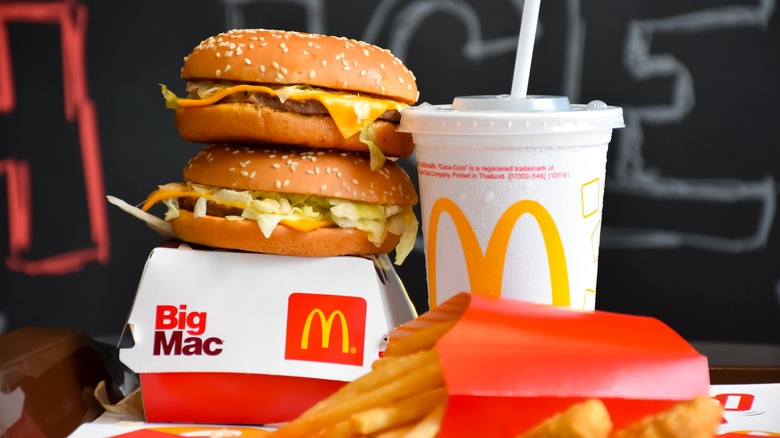Fast Food Restaurants That Started Serving Something Completely Different
Opening a restaurant is an extremely difficult thing to do. Even if an entrepreneur has plenty of cash on hand, a great concept, delicious recipes, and devoted employees, it can still be tough to turn a profit — at least for a while. Countless fast food restaurants have come and gone in the United States over the last 70 years or so, unable to overcome daunting stressors like intense competition, the increased cost of operation, devastating scandals, or changing public tastes.
The food business is much about business as it is about food (if not more), and the founders and minds behind many fast food companies realized early on, before they even expanded to hundreds or thousands of outlets, that if they wanted to hang around and compete, they'd have to change something about the way they ran things. For a number of famous and now dominant fast food chains, the solution to the growing pains, or the way to rescue a financially sinking ship, was to completely change the menu. Here are some familiar fast food eateries whose menus once offered customers wildly different options than what they do nowadays.
The founder of Popeyes sold doughnuts before chicken
Few fast food enterprises make their chicken as spicy or take such deep cues from traditional Southern and Louisiana culinary traditions as Popeyes. In 2019, it launched the fast food chicken sandwich wars with the release of the Popeyes chicken sandwich inspiring runs, shortages, and rip-offs aplenty. None of this would have happened had the man who founded Popeyes — which is named after Gene Hackman's character Popeye Doyle from the 1971 movie "The French Connection" — stuck to his original business plans.
At age 18, Al Copeland sold his car and used the proceeds to open an eatery in his hometown of New Orleans. It was a doughnut shop, and he was the sole proprietor and only employee. For 10 years, Copeland worked in his doughnut shop, turning a small profit until he was inspired to change things up by the wildly successful fried chicken menu offered by Kentucky Fried Chicken in the late 1960s and the early 1970s. Copeland took his profits from the doughnut business and opened a chicken spot in the early 1970s called Chicken on the Run. It couldn't compete with the market dominance of Kentucky Fried Chicken, however, and after six months, Copeland revamped the business entirely. He made his fried chicken less generic, introducing a spicy, Cajun-adjacent recipe, and changed the name from Chicken on the Run to Popeyes.
Tim Hortons made burgers, not doughnuts
Tim Hortons is an indelible part of Canadian life. The chain sells a variety of sandwiches, drinks, and other items, but it's primarily known for its coffee and doughnuts. Millions of Canadians make a stop at one of nearly 3,600 "Timmies" each morning to order a coffee using special slang (a "double-double" is a drip coffee with two sugars and two creams) and a doughnut or a box of Timbits.
Jim Charade, a sales rep for Canadian snack cake maker Vachon, urged his bosses to open a nationwide doughnut chain, but they weren't interested. In the early 1960s, he thought about expanding American chain Mister Donuts' operations into Canada, but then opened his independent Your Do-Nut Shop in Scarborough, Ontario, in 1962. The business was slowly failing when he met a celebrity at a barbershop — NHL hockey star Tim Horton. After buying a car from Horton (who worked at a local dealership during the NHL offseason), Charade pitched the athlete on bringing him into his doughnut company. Horton didn't think doughnuts would sell, but that hamburgers would, so they formed a corporate partnership and created a few fast food hamburger spots in and around Toronto. In less than two years, the hamburger enterprise went out of business due to poor sales. Finally, at that point, Horton acquiesced to Charade's doughnut plan and lent his famous name to the first Tim Hortons outlet in Hamilton, Ontario.
Potbelly grew out of an antiques store
Every one of the more than 400 outlets in the Potbelly Sandwich Works chain includes a unique and impressive item in its decor: a potbelly stove. Both a source of heat and a place to cook in homes of a bygone era, the presence of the stove signals old-fashioned quality and heartiness to Potbelly's customers while also serving as a nod to the company's origins. Nowadays, Potbelly serves towering sandwiches full of hearty meats and cheeses, but the company's original location didn't even initially sell food.
In 1971, Peter Hastings opened a small antique store in Chicago's Lincoln Park area. To drum up business, Hastings sold low-cost Italian-style submarine sandwiches assembled on bread that was toasted on the premises on an old potbelly stove. By 1977, selling sandwiches proved way more profitable than selling old housewares, so Hastings cut way back on the antiques to add room for tables and chairs for customers to eat. He renamed the business Potbelly and just kept a few antiques around for ambiance so as to completely focus on food service. In 1996, Potbelly regular Bryant Keil purchased the store and set about expanding it, growing the brand into a 250-store chain by 2008.
Taco Bell previously sold hot dogs
In 1946, a freshly discharged Marine named Glen Bell went into business for himself in the Southern California enclave of San Bernardino, opening a modest cart selling hot dogs. By 1952, Bell had sold so many franks on buns that he upgraded his cart to a full-fledged hamburger and hot dog stand.
Bell's business was moderately successful, but his profits paled in relation to the restaurant just across the road: a Mexican restaurant called Mitla Café. Catering to a customer base consisting primarily of Mexicans and Mexican-Americans, Mitla Café is credited as the first establishment in the United States to sell hard-shell tacos. Bell, noticing the popularity of those crunchy tacos in particular, would head over to Mitla late at night and pepper the staff with questions about their process for making and assembling tacos. Before long, Bell added tacos made in the Mitla style to his menu and in 1962, in nearby Downey, California, he opened the first freestanding Taco Bell.
Sonic began as a root beer stand
After his two-year stint in the U.S. Air Force finished with the end of World War II in 1945, Troy N. Smith moved back to his home state of Oklahoma and opened a few restaurants in the town of Shawnee, including a diner, a fancy steakhouse, and in 1953, a small root beer stand. Something of a prototypical 1950s drive-in, that stand, the Top Hat, was Smith's most profitable venture by far, and he poured his energies and finances into that, as it was clearly the wave of the future at that point.
On a road trip, he visited a fast food restaurant on the Texas-Louisiana border that used an intercom system for customers to order from their cars. Smith acquired the same setup and installed it at the beverage-oriented Top Hat. The novelty made his business explode, and the renamed Sonic soon expanded its menu to incorporate other familiar drive-in fare like hot dogs, hamburgers, fries, and dozens of drinks and sodas beyond root beer. It would grow into about 3,600 locations in 42 states by the time Smith died in 2009.
Captain D's put burgers on the menu
With a name like Captain D's, this fast food chain immediately advertises to potential customers its status as a fried fish joint. However, the company began under a different name selling more than just seafood, making the oceanic name change when fish became its primary culinary focus.
Now a chain of more than 540 outlets, almost all of them in the southeastern United States, Captain D's started life as one restaurant in 1969 in Donelson, Tennessee. It was originally called Mr. D's Seafood and Hamburgers. By 1973, the chain's then-novel concept of decent fast food priced to middle-class consumers had been so successful that operators built Mr. D's into a chain of 15 locations. All the while, the company sold hamburgers, as if to hedge its bets and offer something for those who didn't like seafood that much. The seafood sold enormously well, much more so than the burgers, and in 1974, Mr. D's dropped beef and adopted a menu centered on fish and shrimp. Making the switch official, Mr. D's rebranded as Captain D's.
Carl's Jr. sold tamales and hot dogs
While working as a Los Angeles bread delivery driver in 1941, Carl Karcher saw hot dog stands popping up all over town. Karcher and his wife, Margaret, got in on this early fast food boom with a hot dog stand of their own. It required an investment of $326 — $15 from their savings and $311 obtained by mortgaging their car. The menu on day one of their stand, situated at the corner of Florence and Central in Los Angeles, consisted of hot dogs, chili dogs, and tamales.
Within four years, the Karchers had expanded their business from one stand to four, providing enough start-up capital to launch Carl's Drive-In Barbecue in Anaheim, California. A full-service restaurant with indoor seating, the menu prominently featured flame-charbroiled hamburgers. The burgers sold so well that in 1956, Karcher opened two stripped-down versions of his barbecue joint which served primarily burgers and offered them quickly and inexpensively. After four years, there were four of these smaller Carl's burger shops around the Los Angeles area. They were named Carl's Jr. because they were a smaller version of the flagship Carl's Drive-In Barbecue. Eventually, Carl's Jr. became the flagship brand, leaving Carl's Drive-In Barbecue in the dust.
Hardee's sold Southern fare
Following the end of World War II in 1945, Wilber Hardee settled in Robersonville, North Carolina, and opened a service station and bus terminal with his brother-in-law that sold a lot of sandwiches to travelers. He didn't like the job, sold his stake to his brother, opened another service station, sold that one, too, and moved across the state to Greenville to work as a kitchen cabinet installer. After buying a house, he felt the need to head back into food service and purchased a vacant building outside of town. There, Hardee opened an informal sit-down restaurant called the Do Drop Inn, which he sold a year after its debut. He then opened a similar establishment called the Port Terminal Inn.
Again, Hardee flipped the business and used the profits to open another eatery in 1949, the Silo Restaurant. To the menu of old-fashioned dinner items, Hardee introduced chicken wings, steaks, seafood, fried chicken and biscuits, and Carolina barbecue. A separate part of the Silo operated as a drive-thru, selling charbroiled hamburgers. After launching another Silo, in 1956, Hardee's created a fast food spot called Sandwich King, selling hot dogs and hamburgers. That, in turn, led to the nearly identical Ivory Castle in 1958 and the first Hardee's in 1960.
Chick-fil-A sold burgers
Chick-fil-A is staunchly a chicken-based operation. While other fast food corporations may test out other protein options to attract new customers, Chick-fil-A remains devoted to poultry. Purporting to have invented the boneless, breaded, and fried chicken sandwich, Chick-fil-A's menu now includes chicken nuggets, chicken strips, chicken salads, chicken soup, and chicken breakfast sandwiches. For two decades, its ad campaigns and marketing materials have revolved around slaughter-fearing cows encouraging the public to "eat mor chikin," specifically at Chick-fil-A. It's downright bewildering that the chain of nearly 3,000 American quick-serve outlets began as an offshoot of a diner that proudly served hamburgers — and still does.
In 1946, Truett Cathy opened the Dwarf Grill in Hapeville, Georgia. The Dwarf Grill (later renamed the Dwarf House) sold entrees like Dwarf Burgers and Giant Burgers. In 1964, Cathy created his first chicken sandwich at the Dwarf House, ultimately inspiring him to create Chick-fil-A. The Dwarf House (torn down and remodeled more than once) remains open in its original location with its burger-based menu intact, adjacent to a Chick-fil-A.
Dunkin' was a sandwich truck
Years before vast swaths of Americans took a brief stop during their morning workday commutes to pop into a Dunkin' for a cup of coffee and a doughnut or breakfast sandwich, the eatery went directly to the workers.
William Rosenberg worked as an ice cream truck driver in the 1930s before teaming up with Harry Winokur to open a mobile catering business just after World War II to feed laborers in and around the Boston area. In what would today be called a food truck, Rosenberg and Winokur sold sandwiches, coffee, and doughnuts from vehicles that they'd park by factories. Realizing that the coffee and doughnut sales brought with them high profit margins, Rosenberg broke off from Winokur to start a brick-and-mortar doughnut shop. The Open Kettle, as Rosenberg called it, was a lucrative endeavor, and in 1950 he opened another Quincy, Massachusetts, doughnut place, calling it Dunkin' Donuts.
McDonald's originally sold orange juice
Brothers Maurice and Dick McDonald left New Hampshire in the 1920s and moved to Hollywood where they found work as physical laborers in the then-new movie industry. Frustrated with how they never got the chance to make their own movies, the McDonalds pooled their savings and bought a large movie theater in Glendora, California, which they renamed the Beacon Theatre. That project quickly met its financial doom; it was in the midst of the Great Depression, and movie attendance and snack bar sales suffered.
One enterprise that seemed successful to the McDonalds was orange juice stands. In 1937, they sold their movie theater and opened The Wigwam in Arcadia, selling orange juice to go. The brothers next sold hot dogs, orange juice, and hamburgers at The Airdrome in Monrovia. Three years after getting into the food business by way of orange juice and hot dogs, the McDonalds moved The Airdrome 40 miles away to the growing city of San Bernardino, retitling it McDonald's and deciding to focus less on hot dogs and more on hamburgers and french fries.
